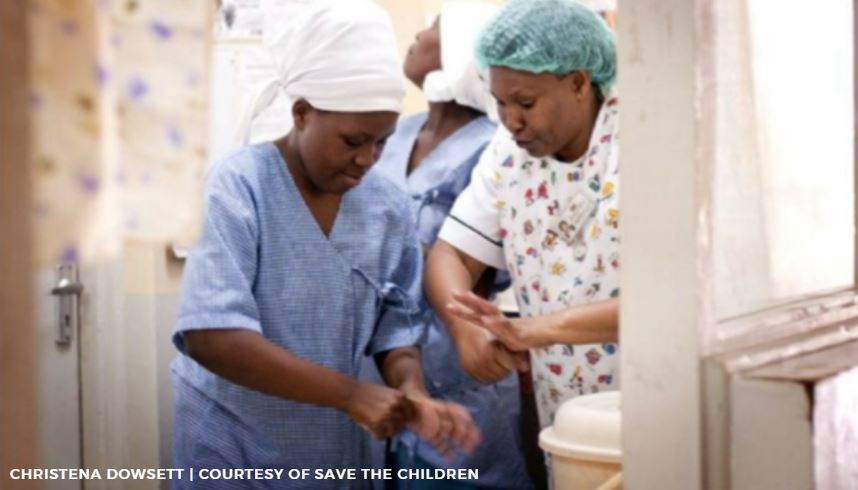Learning Page: Healthcare Facilities
Published: October 23, 2018
Access to improved WASH can help prevent the spread of healthcare-associated infections and allows healthcare staff to offer safe, clear, and desirable treatment and services to patients.

Yearly, an estimated 15% of patients develop one or more infections during a hospital stay and that at any given time 10 of every 100 hospitalized patients in developing countries acquire at least one healthcare-associated infection.
The lack of access to an improved water source and availability of soap at many healthcare facilities in resource-limited settings and gaps in the awareness of the importance of enhanced hand hygiene and infection prevention & control undercut the ability for healthcare staff to offer safe services and for patients to protect themselves from acquiring infections. For healthcare providers, patients, and visitors to be able to practice good hand hygiene in health settings, water and soap must be accessible.
However, a recent UNICEF/WHO report on the availability of WASH in 66,000 healthcare facilities in 54 countries acknowledged that that 38% of healthcare facilities did not have an improved water source, 19% did not have improved sanitation facilities, and 35% did not have soap and water for handwashing.
GHP Resources on WASH in Healthcare Facilities
Hygiene in Healthcare Facilities Fact Sheet
Good hygiene is critical to ensure that healthcare staff provide quality care, reduce the spread of infections, and protect the health of communities. Our fact sheet explores the healthcare-related risks of poor hygiene and the critical elements of hand hygiene needed to improve quality of care and reduce negative outcomes of poor compliance in healthcare facilities, and provides recommendations improving hygiene in health settings and achieving a safe, clean healthcare environment. Read the fact sheet here.
Hygiene in Health Facilities Infographic
Adequate WASH in healthcare facilities is an important way to prevent the spread of infections like sepsis. Sepsis is the leading cause of death for patients, particularly mothers and newborns. Our infographic introduces key data on hand hygiene and sepsis and actions you can do to advocate for improved WASH in healthcare facilities. View the infographic here.
Hygiene Advocacy Toolkit
Hygiene matters in the context of the Sustainable Development Goals. Our toolkit includes tools and resources to help hygiene advocates ensure that handwashing with soap is recognized as a critical part to health and development. This toolkit outlines specific audiences to target in promoting and facilitating handwashing, key messages for hygiene advocacy, and approaches to engaging others in advocacy. It also includes tips for social media, meetings with policy makers, and other common advocacy activities. Access the toolkit here.
WASH Counts in Healthcare Facilities webinar
On 3 May 2017, Medentech & the Global Handwashing Partnership hosted a webinar in celebration of Hand Hygiene Day, which takes place annually on May 5th. During this webinar, the World Health Organization, USAID’s Maternal & Child Survival Program, the Beninese Association for Social Marketing, and Medentech explored how improved WASH prevents the spread of healthcare-associated infections how to catalyze behavior change around proper hygiene, and how to improve safer conditions and services for patients and their families in healthcare facilities. Presenters also shared how they are innovating to improve WASH services and combat infection spread in health settings. Read the webinar summary and access the webinar recording here.
WEDC Summary
At the 41st WEDC, the Global Handwashing Partnership, Aquatabs, Amref Health Africa, Tufts University, and World Vision convened a discussion on sustaining behaviors and practices for water, sanitation, and hygiene in health facilities to improve patient safety and quality of care. Read the summary of the event here.
Useful Resources & Links
WaterAid/World Health Organization
- Role of WASH sector in healthcare facilities fact sheet
World Health Organization
- Role of WASH in achieving quality universal health coverage infographic
World Health Organization/UNICEF
- 2015 Global Assessment of WASH in Healthcare Facilities report
- WASH in HCF Global Action Plan brief
- Healthcare waste management training module
- Tackling Antimicrobial Resistance infographic
- Water & Sanitation for Health Facility Improvement Tool (WASH FIT) tool
TAGS: Briefing Paper Hygiene in Health Facilities ImplementersGeneral PublicAdvocates 2018